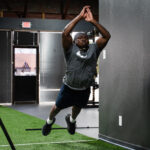Sports Performance Training for Injury Prevention
No athlete wants to spend time on the sidelines. Injuries not only derail your season but can also lead to long-term setbacks. That’s where sports performance training becomes a powerful tool—not just for improvement, but for injury prevention.
By strengthening key muscles, correcting imbalances, and improving movement, you reduce your risk of getting hurt. In this post, we’ll dive into how sports performance training keeps athletes healthy and in the game.
The Link Between Training and Injury Prevention
Injury prevention isn’t just about stretching or warming up. It’s a full-body strategy that begins long before game day.
Sports performance training focuses on:
-
Muscle balance
-
Joint stability
-
Flexibility and mobility
-
Neuromuscular control
-
Movement mechanics
When all of these are addressed together, athletes move better and safer. Fewer injuries mean more consistent progress and peak performance when it counts most.
Strengthening Weak Links
Many injuries occur because of weak or underused muscles. Think about how many athletes suffer ACL injuries from poor glute or hamstring activation.
Sports performance training identifies and strengthens these weak points. Coaches often target:
-
Glutes and hips
-
Hamstrings
-
Core muscles
-
Rotator cuff and scapular stabilizers
By strengthening these areas, you create a more stable base for movement. This stability reduces the load on joints and soft tissues during play.
Improving Mobility and Flexibility
Tight muscles restrict motion, forcing the body to compensate. These compensations often lead to overuse injuries or sudden tears.
Mobility training improves range of motion in key joints like:
-
Ankles
-
Hips
-
Shoulders
-
Thoracic spine
Flexibility work includes dynamic warm-ups, foam rolling, and targeted stretching.
A mobile body is more agile, more explosive, and less likely to break down under stress. As NSCA’s injury prevention guide notes, mobility is crucial for proper movement patterns and force absorption.
Movement Quality Over Quantity
It’s not just about working hard—it’s about moving right. Sports performance training emphasizes quality movement patterns, including:
-
Squats
-
Lunges
-
Pushes and pulls
-
Running form
-
Jumping and landing
Poor mechanics can lead to chronic issues like tendonitis or stress fractures.
Trainers use assessments to identify bad habits and correct them early. When you move well, you train safely and compete more effectively.
Stability and Balance Training
Balance and stability are underrated parts of athletic performance. They keep your joints aligned and muscles working together.
Sports performance training includes:
-
Single-leg exercises
-
Balance board work
-
Core stabilization drills
-
Eccentric training (controlled lowering)
These tools help control movement under pressure. That means fewer awkward landings, twisted knees, or rolled ankles.
And yes—it also makes you stronger and more explosive.
Prehab Is the New Rehab
Prehab, or preventative rehab, is a growing focus in sports training. It involves exercises that protect common injury zones.
Prehab routines often include:
-
Shoulder band work
-
Hip mobility drills
-
Ankle stability training
-
Thoracic spine stretches
These short routines are typically done before workouts or games. They prime the body for movement and reduce injury risk.
At Next Level Athletics, injury prevention is built into every program—so athletes stay strong and stay playing.
Recovery Is Part of Prevention
Recovery is just as important as training. Without it, your body can’t repair and grow.
Recovery strategies in sports performance training include:
-
Active recovery days
-
Sleep optimization
-
Nutrition for muscle repair
-
Hydration and electrolyte balance
-
Foam rolling and stretching
Overtraining and fatigue are major causes of injury. Learning to listen to your body and respect rest helps keep you in the game.
Sport-Specific Injury Risk Reduction
Each sport has its own injury risks. Baseball players often deal with shoulder and elbow issues. Soccer players face ankle sprains and ACL tears.
Sports performance training is tailored to your sport’s demands. For example:
-
Volleyball players strengthen landing mechanics to avoid knee issues.
-
Runners improve hip strength and stride form to prevent shin splints.
-
Football players focus on neck and shoulder stability to reduce impact injuries.
This targeted approach ensures the most vulnerable areas are protected.
Mental Focus and Body Awareness
Injury prevention isn’t just physical—it’s mental too.
Sports performance training helps athletes:
-
Focus on movement quality
-
React quickly to changing environments
-
Build proprioception (body awareness)
This reduces “panic reactions” during competition, such as twisting or overextending. The more aware and in control you are, the less likely you are to get hurt.
Conclusion: Train Smart, Play Long
Injuries aren’t always avoidable—but many are preventable. Sports performance training helps reduce risk by building strength, mobility, balance, and smart movement habits.
By investing in injury prevention, you extend your athletic career and get more from every season.
Train hard, train smart, and stay on the field where you belong.


Recent Comments